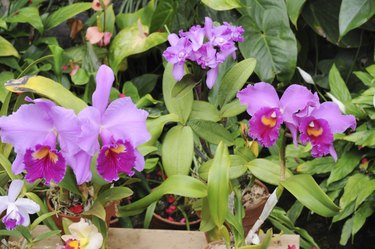
The flowers of orchids (Orchidaceae) last several weeks or several months, depending on the orchid species, but once they go into dormancy, you might wonder how to make an orchid bloom again. Tropical orchids bloom in a variety of colors, ranging from white through reds, pinks, yellows and all mixtures between. Orchids often need a different care routine than other indoor plants, and following those care guidelines helps your orchid bloom again.
Dealing With Orchid Dormancy
Video of the Day
When you buy your orchid, it likely has a beautiful bloom on it. However, your orchid will eventually stop blooming and begin a resting period, during which it replaces nutrients. This period can last between 6 and 9 months to regain the energy it needs for another round of blooming.
Video of the Day
You can make an orchid bloom again during its resting phase by fertilizing it at least monthly. Placing your orchid in a slightly cooler spot between 55 and 65 degrees Fahrenheit with indirect sunlight can also help. After the flower spike starts to grow, support it with a stake and watch for signs of blooming. If you don't see any blooms within a few months, try a new location for your orchid. Make sure you're also following basic orchid care to promote blooming for your particular type of orchid.
Container and Potting Medium
An orchid grows well in either a clay or plastic pot. A clay pot allows easier absorption of oxygen to the plant. The hole on the pot's bottom can be enlarged to ensure adequate drainage. Repot your orchid if its current container doesn't promote good growth.
Orchids don't thrive on garden soil and don't bloom well when planted on an ordinary houseplant potting medium. The thick, fleshy roots of an orchid attach themselves to tree bark in the plant's natural growing environment. The roots absorb nutrients from the air and bark rather than from soil. Use a commercially prepared orchid potting medium that contains chopped tree fern fiber, volcanic rock, charcoal, peat moss, fir bark or a combination of these to ensure healthy growth and blooming.
Orchid Light Level
Lack of sufficient light is the most frequent cause of an orchid's failure to bloom. Orchid leaves are light, grassy green with yellow undertones when they receive sufficient light. Dark-green leaves indicate the plant doesn't receive enough light. Cymbidium (Cymbidium spp.) species orchids, which are hardy in U.S. Department of Agriculture zones 10 through 12, are often grown in the dappled shade of large trees.
An east- or south-facing window with bright filtered light provides the optimal environment for a blooming orchid. Too much direct sunlight causes burn spots on the leaves. A sheer curtain can be used to create desirable shade. Move the orchid closer to or further from the window to manipulate the amount of light the plant receives.
Air and Water
Orchid roots must have freely circulating air with gentle flowing movement. A stagnant atmosphere discourages healthy growth and bloom development. An overhead paddle fan set on the lowest speed, an open window or a slow-moving fan across the room move air sufficiently for orchid health. A fan should be directed away from the plant.
During the growing season, an orchid prospers with once-a-week watering, unless it dries out sooner. A plastic pot feels lighter when its potting medium is dry than when it's wet, and a clay pot feels dry to the touch when its potting medium is dry. When watering, soak the potting medium thoroughly so water runs out the bottom of the pot. Thorough soaking flushes out fertilizer salts that accumulate.
Regular Fertilizer Schedule
Most orchid species have their bloom cycles in late winter or spring. They grow and flower for fairly long periods of time without fertilizer but produce more blooms when fertilized regularly. Use a water-soluble or granulated type commercial fertilizer specially formulated for orchids to help make an orchid bloom.
Prepare the fertilizer according to the instructions with room-temperature water. Moisten the surface and roots only, not the foliage. Allow the water to run through the potting material and out the drainage hole. Follow a fertilizing schedule of every two weeks during active growth phases and every four weeks during rest cycles. Reduce water after spring flowering until new growth appears.